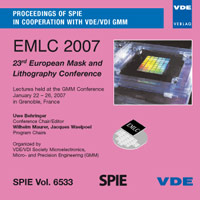Characteristics optimization of mask materials for Hyper-NA lithography
Conference: EMLC 2007 - 23rd European Mask and Lithography Conference
01/22/2007 - 01/26/2007 at Grenoble, France
Proceedings: EMLC 2007
Pages: 8Language: englishTyp: PDF
Personal VDE Members are entitled to a 10% discount on this title
Authors:
Morikawa, Yasutaka; Suto, Takanori; Nagai, Takaharu; Inazuki, Yuichi; Adachi, Takashi; Kitahata, Yasuhisa; Yokoyama, Toshifumi; Toyama, Nobuhito; Mohri, Hiroshi; Hayashi, Naoya (Dai Nippon Printing Co., Ltd., 2-2-1 Fukuoka, Fujimino-shi, Saitama 356-8507, Japan)
Abstract:
Hyper-NA lithography with polarized light illumination is introduced as the solution of 45nm or 32nm node technology. In that case, consideration of new characteristics of masks and substrates has been required. Mainly, following three materials, quartz substrates, absorber or phase shifter materials and pellicle films, have been discussed for that issue. Item to be discussed on quartz substrates is birefringence. It has been said that birefringence of quartz substrates affects printed CD on the wafer and is required to control on the masks or substrates. We will report how substrate birefringence affects the printed CD error by 3D simulations. Item of absorber or phase shifter material is optical characteristics. We will discuss about how optical parameters of mask materials affect to diffracted light intensity balance and how these characteristics also affect to printing performance by 3D simulation results. In the result of this section, we will show current 6%EAPSM film has good printing performance down to half pitch 45nm. Item of pellicle film is thickness optimization. It has been described in some papers that the issues will occur if the film’s characteristics will not been changed. Main issue is transmission change caused by film thickness variations. We will report current pellicle film’s performance and will propose how to minimize this issue by the thickness optimization. In order to confirm those items, we used the pattern model as minimum half-pitch = 45nm and target CD on the wafer = 45nm for 3D simulations. The illumination condition of the scanner was used as maximum NA=1.35, Dipole or Cross quadrupole shape and polarized illumination.


